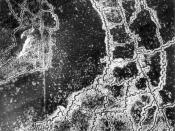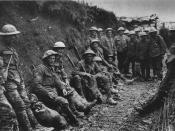World War 1 is perhaps best known for being a war fought in trenches, ditches dug out of the ground to give troops protection from enemy artillery and machine gun fire. In spite of the fact that the trenches protected the soldiers, they stood no chance against the diseases. Body lice were among one of the diseases that traveled among the trenches the most. Body lice caused frenzied scratching and led to trench fever. Fifteen percent of sickness was from body lice. Trench foot was another disease found in the trenches. After hours of standing in waterlogged trenches, the feet would begin to numb, change color, and swell, and this would soon result in amputation. There was one way to cure trench foot without amputation, and that was to dry feet and change socks regularly. During the winter of 1914-15, over 20,000 men in the British army were treated for trench foot. Whale oil was used to oil the soldiers' feet because it was much easier to take off their boots. Ten gallons of whale oil was used at the front lines. With the dead and dying soldiers, rats were not far behind. Rats that could not find food in trenches resorted in eating human flesh.
The German trench system was more elaborate and, according to some reports, better build and maintained. This was due to the fact that for long periods the German army was on the defensive, and needed an environment which would enable their men to resist the massive bombardments and assaults of the allies. When soldiers thought that the trenches would protect them from harm, they were in for an unsuspecting surprise. Throughout the war, the allies used five million tons of artillery shells against the enemy. In the first two weeks...


